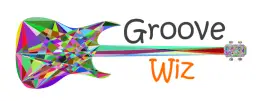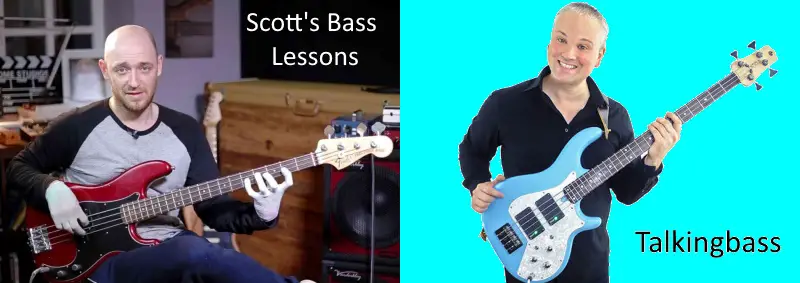Talkingbass and Scott’s Bass Lessons are no doubt two of the most popular online bass courses. Each has a vibrant Youtube channel (270+K and 810+K subscribers respectively) and paid online video courses.
If you’re bass player, beginner or experienced, trying to pick for a course to take your skills to the next level, you’re probably wondering which of takingbass or Scott’s Bass Lessons is the best choice for you.
While there is a ton of feedback on both courses all over the web, this post summarizes the most important stuff for each and the biggest differences between them.
| Scott’s Bass Lessons | Talkingbass | |
|---|---|---|
| Free videos style: | vlog style, hang out | proper lessons, drills |
| Course best for: | more advanced learners | beginners |
| Subscription type: | annual, unlimited access | course by course |
| Teaching style: | varied courses, guest lecturers | college-style, linear |
| General focus: | overall musicianship | bass technique & theory |
| Members like: | endless learning resources | structured approach |
See also:
is Rocksmith good for learning bass?
Studybass Review: In-Depth Lessons For Bass Musicianship
How Hard Is Learning Bass Guitar?
The following are some key highlights about these two courses and how they compare, based on both a personal experience and other user feedback:
- You can’t go wrong with either Scott (Scott’s Bass Lessons) or Mark (Talkingbass), it’s all about your learning style
- Both SBL and Talkingbass paid courses are organized curriculum with learning paths in contrast to Youtube videos about random aspects of playing. They’re both very good.
- The paid SBL course has a large number of lessons and courses covering a broad range of styles and taught by some great bass players
- Both SBL and Talkingbass Youtube channels offer excellent free resources. While SBL’s Scott has awesome star guests on every week, Talkingbass’s Mark does a great job at explaining techniques in a clear and detailed fashion.
- Talkingbass’s YT videos are straight to the point, “get down to the action”. Scott’s videos have a lot more filler chit-chat around the actual lesson. Scott comes across more as a buddy, Mark more as a teacher.
Talking bass’s free content is generally considered better. - Mark generally gives you a drill at the end of each lesson, something Scott doesn’t do as much.
- Scott’s Bass Lessons paid course is geared toward more advanced students and has a “all-you-can-eat” approach – you can choose freely among a large number of lessons – it can be hard to know what to do next.
Talkingbass’ lessons are more organized, linear, and less overwhelming for beginners. - Talkingbass is often considered better at teaching the basics of learning the bass and playing written music. Scott’s course, meanwhile, may be better for the long run due to the endless resources for being an all-around bass musician.
- Scott’s Bass Lessons include an impressive amount of courses for a reasonable annual fee ($175). Members tend to find more and more of the material valuable as they progress.
- Talkingbass is generally considered a better place to start. The starter pack is a good deal at $85. However each additional course will cost $85-90 which can add up quickly compared to SBL’s unlimited annual fee. There is an all-access pass as well but it’s not available all the time.
- Scott’s Bass Lessons is seen as not structured enough for newbies but has a lot more content than Talkingbass for the money and more focus on long-term musicianship. Some beginners start with Mark but later move on to Scott.
- Talkingbass has more of a traditional instructor-led, music college style course feel with a clear progression path and a focus on sight reading. SBL has more of a hang out type of vibe. Mark is more detailed than Scott for explaining techniques
- Instructors and staff on SBL are always ready to answer member questions no matter how many times they’ve already been asked, which is not as much the case on Talkingbass.
Note: many bass learners also recommend Hal Leonard’s bass lesson books
Table of Contents
Scott’s Bass Lessons: strengths & weaknesses
SBL strengths
It’s important to remember that Scott Bass Lessons’ Youtube videos and paid course are very different things. The subscription lessons are much more focused and direct compared to the YT videos, and well-organized into a learning curriculum.
The main strength of Scott’s Bass Lessons’ paid offering is no doubt the sheer amount of content it offers – more than can be consumed in a lifetime. It’s organized into separate courses that paying members can take any time.
There are courses on everything from chords and scales for the bass, rhythm, music styles (blues, jazz, slap) etc. Courses are taught by different instructors, many of which students find really good.
Members generally enjoy the intro course which does a good job at helping you identify your weaknesses and improvement goals.
Following the introduction course, you can move on to different topics such as learning chords and modes, how to groove and stay in the pocket, or how to create a good bassline based on the what the rest of the band is doing.
Some learners appreciate that Scott focuses right from the start on building good habits, such as using the two-finger alternate fingering as opposed to having the student get comfortable with a single finger at first.
A feature often mentioned as a favorite among Scott Bass Lessons members is the weekly guest seminars where great famous bassists are brought in, as well as guest courses or lectures taught by these bassists.
While the large amount of material can feel overwhelming for beginners, members have welcomed the leveled Player Path learning path system Scott recently rolled out, which helps approach the content in a more organized and progressive fashion.
Learners also praise the backing tracks made available to members as well as Scott’s performance suggestions for the pieces studied.
SBL Weakness
As mentioned, Scott Bass Lessons’ Youtube videos are relatively long with a lot of chatter – which tends to annoy quite a few viewers. Scott sometimes rambles on for a long time with only a small portion of the video being on-point.
Viewers tend to (wrongly) view the Youtube videos as previews of the paid course teaching style. They get put off by the non-essential banter, the sometimes generic concepts presented, and the marketing-focused, click-baity style of the vlog.
Regarding the paid course, members often feel some courses are better than others, while some instructors are not as good as Scott Devine himself.
The growing number of guest courses tends to reduce the general quality of the instruction. The material some guests offer, while interesting and inspiring, is not pedagogical enough.
As I mentioned previously, some feel the SBL lessons is a bit like a large collection of useful instruction but with insufficient direction (non-linear), especially for those who favor a linear learning style. This is improved, however, by the Player Path feature.
Some users would like to see sheet music on the screen when practicing.
Members also get annoyed by the aggressive marketing offering to buy additional classes. Some feel nice extra features like the fretboard accelerator should be included in the subscription price.
Talkingbass strengths & weaknesses
Talkingbass pros
Generally speaking, bass learners are very enthusiastic about Mark’s Talkingbass free Youtube videos as they feel they’re down to the point, focusing on the lessons and exercises, as well as numerous playlists for all sorts of music.
The aspect learners probably value the most is the structured, direct, and effective way Mark presents his learning material.
Viewers also enjoy Mark’s teaching style as he not only shows them the techniques but also explains the reasons behind them. Some say Mark is the teacher they wish they had in person for starting the bass.
Mark goes through all the important basics and explains every aspect of them, answering a lot of the small questions beginners have. Viewers generally find him much more detailed than Scott Devine.
Many people feel Mark has a gift for breaking down information into bite-size pieces in a very clear fashion.
Viewers appreciate the Youtube videos, often viewed as an amazing free resource, for their structure and pedagogical approach. Through them, viewers often get drawn into buying a paid subscription for accessing more advanced content.
Talkingbass’ audience also value the fact that Mark J. Smith has a First Class BA(hons) Degree in Music from Leeds College of Music, and many years of experience teaching in music colleges and universities in the UK.
The paid courses are described as well-thought-out and produced. The associated pdf guides (e.g. the huge sight reading course guide) are very thorough and offer great value.
Mark is always available to answer student questions via email and during the Q&A section of the weekly Talkingbass live event. Students can even send a video of them playing and get customized feedback from him.
Overall, members feel the paid course is well-worth the money.
Talkingbass cons
Talkingbass members have few qualms about the courses, aside from the fact that buying each course individually can add up quickly – as mentioned, Talkingbass does have an all-you-can-eat annual pass but it’s only offered a few times a year.
A few learners say Mark is moving a little too fast for them, but most are overall happy with his teaching style and content.
Final words
Scott’s Bass Lessons and Talkingbass both offer valuable free and paid learning content for new and advanced bass players alike.
SBL’s free Youtube channel has more of a vlog format and is less lessons.focused than Talkingbass, and hence not as well-suited for beginner learners.
SBL’s subscription website, however, is incredibly rich in terms of learning material and offers endless resources for long-term bass improvement at an affordable annual price.
Talkingbass, while not as resource-rich, has a more progressive and didactic teaching style that many learners enjoy, albeit on a course-by-course pricing basis.
***
Photo credits:
Featured image: Scott’s Bass Lessons, Talkingbass

